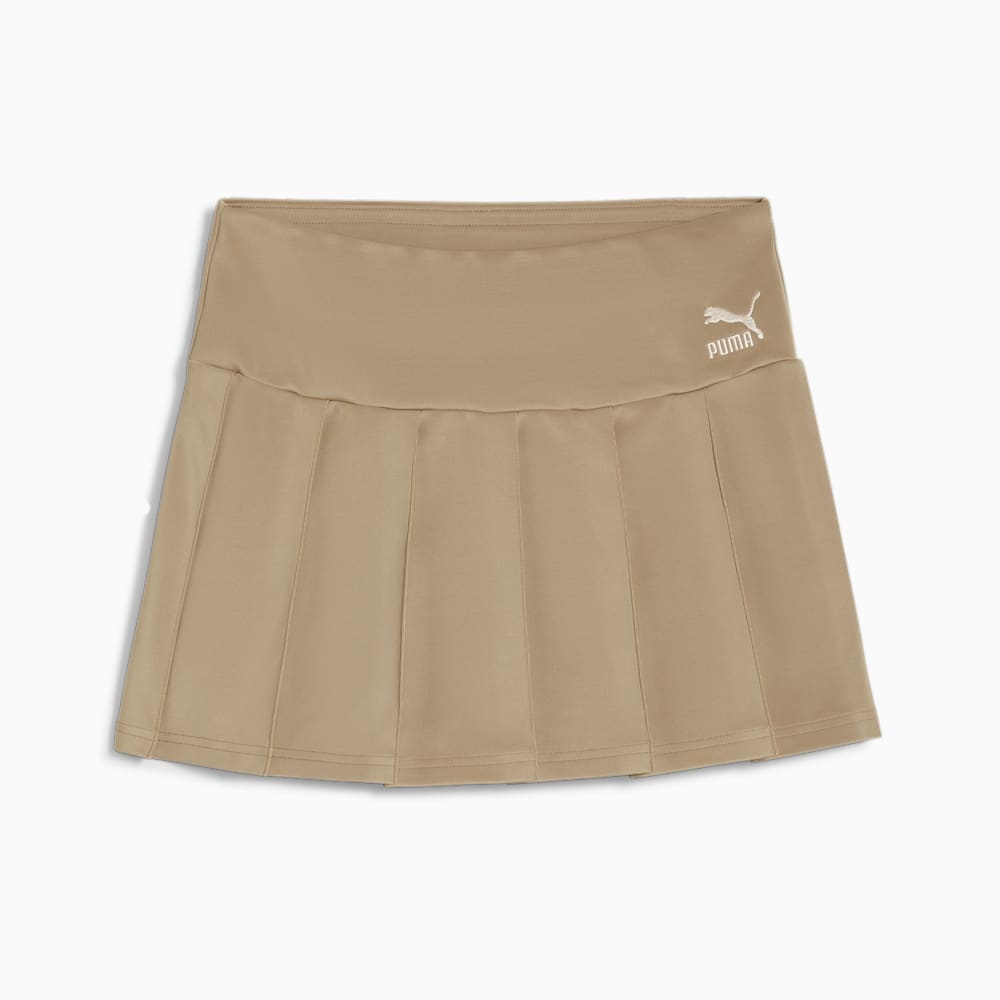Types of Skirts and Their Silhouettes
Under the skirt! Skirts come in many shapes and sizes, each with its own flair and function. Knowing the types and their silhouettes helps to pick the perfect skirt for any occasion. Let’s explore the common styles and their unique silhouettes.

A-Line Skirts
These skirts flare out gently from the waist, forming an ‘A’ shape. They are great for almost all body types and come in various lengths. A-line skirts provide a balanced look, perfect for both casual and formal settings.
Pencil Skirts
Pencil skirts are fitted and follow the line of the body, with a narrow cut that often has a slit for ease of movement. Ideal for office wear, they outline the figure and pair well with tailored tops.
Maxi Skirts
Maxi skirts flow down to the ankles, offering a comfortable yet chic style. They are versatile, suitable for both summer beach days and cooler evenings. The long silhouette makes them a favorite for a relaxed, bohemian look.
Mini Skirts
Mini skirts sit high on the thigh, making a bold fashion statement. They are best for those who want to show off their legs and can be styled in countless ways, from sporty to elegant.
Pleated Skirts
With their vertical folds, pleated skirts create volume and movement. They can be short or long, and the intricate folds work well for a polished and preppy appearance.
Wrap Skirts
Wrap skirts feature a front closure that ties at the waist, giving an adjustable fit. They can be dressed up or down, and the wrap silhouette flatters many body types.
These are just a few examples of skirt types and their silhouettes. Understanding the skirt types helps create outfits that suit personal style and body shape. When considering ‘under the skirt’, it’s essential to pair the right kind of slip, shorts, or leggings for modesty and comfort, especially with shorter styles like mini skirts.

The History of Skirt Fashion
Skirts have a storied past, evolving with time and culture. Let’s take a walk through the history of skirt fashion to see how these garments have changed and what they’ve meant to societies around the world.
The earliest skirts date back to ancient civilizations. They were simple, wrapped garments made from natural fabrics. Both men and women wore them for practicality and ease of movement. In these times, skirts were less a fashion statement and more a necessity of life.
As time progressed, skirts became a mark of social status. In the Middle Ages, the length and fabric of a skirt indicated wealth and position. The elite adorned themselves in long, flowing skirts made of luxurious materials, while peasants wore practical, shorter styles.
The Renaissance period saw skirts become fuller and supported by frames. These were the early ancestors of the hoop skirt. Women’s waists were cinched tight, illustrating a silhouette that emphasized the hips and skirt volume.
Fast forward to the 19th century, and the crinoline was born, ballooning skirts to new proportions. However, the practicality of movement returned in fashion with the introduction of the bustle, which reduced skirt volume and allowed for easier mobility.
The 20th century brought drastic changes. The roaring ’20s flapper styles saw hemlines rise like never before. Post-war, the 1950s brought us the iconic cinched waist and full skirt silhouette, thanks to designers like Christian Dior.
The mini skirt, born in the swinging ’60s, became a symbol of rebellion and freedom. The ’70s and ’80s played with skirt lengths and styles, reflecting the diverse music and fashion scenes.
Today, the skirt is as versatile as ever, reflecting personal style and cultural influences. The long history of skirt fashion showcases humanity’s endless desire for self-expression through clothing.
How to Choose the Right Skirt for Your Body Type
Choosing the right skirt for your body type enhances your appearance and boosts confidence. Consider these factors for a flattering fit:
- Pear-Shaped Body: Aim for A-line skirts. They balance out wider hips by flaring at the bottom.
- Apple-Shaped Body: High-waisted skirts can define the waistline. Flowing skirts like maxis can also create a balanced look.
- Hourglass Figure: Embrace curves with fitted skirts like pencils. They highlight the waist and hips beautifully.
- Petite Frame: Opt for mini skirts to lengthen the legs. Avoid skirts that are too long as they can overwhelm a smaller frame.
- Tall and Slim: Maxi skirts work well, offering a stylish, elongated silhouette that complements height.
- Plus-Size: Look for skirts with vertical patterns or pleats. They draw the eye up and down, creating a slimming effect.
- Athletic Build: Skirts with volume, like pleated or full skirts, can add femininity to a straighter figure.
Every skirt type sits under the skirt differently based on body shape. Ensure to try them on and move around to feel comfort and fit. Remember, the right skirt not only looks good but also feels right and adheres to your personal style.
The Role of Skirts in Contemporary Fashion Trends
Skirts play a pivotal role in modern style. They adapt to suit fresh fashion currents. From runway shows to streetwear, skirts bring versatility to wardrobes everywhere. Modern skirts mix old traditions with new twists. This fusion creates exciting and unique trends.
Reviving Vintage Styles
Retro looks make comebacks with contemporary updates. Pleated and midi skirts, for example, blend past elegance with today’s casual vibe. High-waisted styles echo the past while fitting new body positivity ideals.
Prints and Patterns Galore
Bold prints and patterns dominate modern skirt designs. Florals, geometrics, and abstract prints under the skirt offer pops of color and texture. These elements show personal flair and add interest to outfits.
Sustainability and Ethical Fashion
Eco-friendly skirts are on the rise. Consumers now seek sustainable materials and ethical production. This demand shapes trends toward organic fabrics and transparent supply chains.
Inclusivity in Fashion
Designers now prioritize diverse body types. Skirts with flexible waistbands and size-inclusive ranges are trending. More and more, fashion embraces all shapes under the skirt.
Tech Meets Style
Innovative fabrics and smart textiles revolutionize skirt fashion. Temperature-regulating materials and moisture-wicking fabrics under the skirt cater to comfort and practicality.
Skirts continue to be a staple in contemporary fashion. They offer endless styling options and reflect current social values. They evolve, standing as testimonies of time and taste in the constantly shifting world of fashion.
Pairing Skirts with Tops and Accessories for Different Occasions
Pairing the right tops and accessories with skirts is key for creating fashionable looks. Whether you are dressing for a casual outing, a professional setting, or a formal event, the top you select can entirely change the impact of a skirt. Below, we discuss some versatile combinations to consider for different occasions.
Casual Looks
For a laid-back vibe, pair a mini skirt or an A-line skirt with a relaxed t-shirt or a crop top. Add sneakers or sandals ‘under the skirt’ for a comfortable, everyday style. To elevate the look slightly, throw on a denim jacket or a lightweight cardigan.
Work Environments
In professional settings, pencil skirts and A-line skirts thrive. Combine them with button-down shirts or fitted blouses. Under the skirt, choose modesty shorts or a slip if needed for extra coverage. Finish the look with structured accessories like a belt and a pair of low heels.
Evening Out
For evening events, go for a maxi skirt or a tailored pencil skirt. Tuck in a silk blouse or choose an elegant cami top. Under the skirt, opt for seamless undergarments to maintain a smooth silhouette. Accessorize with statement jewelry and a clutch to add a dash of glamour.
Special Occasions
Floor-length skirts or ornate pleated skirts are perfect for special occasions. Match them with a sophisticated top, perhaps with lace or embellishments. Under the skirt, a long-line shapewear piece can streamline your profile. High heels and fine jewelry will round out your elegant ensemble.
Remember to pay attention to the colors and patterns. They should complement each other ‘under the skirt’ theme. Make sure to consider comfort as much as style, especially if you’re going to wear the outfit for several hours. With these tips, you can confidently match skirts with tops and accessories for any occasion.
The Cultural Significance of Skirts Around the World
Skirts offer more than just style—they embody cultural identity. Different countries showcase unique skirt traditions tied to history, values, and beliefs. Let’s delve into the cultural importance of skirts across the globe.
Traditional Representations
In Scotland, the kilt, a type of pleated skirt, stands as a symbol of Scottish heritage. It is worn on formal occasions and accompanied by traditional regalia. Native American tribes also have unique skirt styles. These are often adorned with specific colors and patterns that carry cultural and spiritual significance. In many Pacific Island nations, grass skirts are part of ceremonial attire, connected to dance traditions and communal gatherings.
Skirts as Social Indicators
Historically, the skirt has been a marker of social status and occupation. The length, fabric, and style of a skirt could indicate a woman’s marital status, community role, and economic position. In parts of Africa and Asia, brightly colored and patterned skirts are part of everyday life, and can also convey marital status.
Religious and Ceremonial Uses
Religious ceremonies often feature special skirts. In Hindu rituals, women might wear long, flowing skirts in vibrant colors as a sign of joy and spirituality. Skirts in Jewish Orthodox practice must adhere to modesty laws, covering the knees ‘under the skirt’ for women.
Skirt Styles in Festivals
During festivals, skirts become more than attire—they’re part of the celebration. Rio’s Carnival sees samba dancers in elaborate, feathered skirts, reflecting the festival’s energy. In Spain, flamenco dancers wear ruffled skirts that enhance their passionate performances.
Political and Social Movements
Skirts have played roles in political statements. The mini skirt was a symbol of liberation in the 1960s. Today, skirts in protests can represent solidarity or defiance against cultural norms.
Understanding skirts’ cultural significance reveals a world of meaning ‘under the skirt’. They are not just fashion pieces, but powerful expressions of identity and heritage. When worn, they connect us to the stories and lives of people around the world.
Care and Maintenance Tips for Skirts
Taking good care of skirts ensures they remain in prime condition. Follow these tips to keep your skirts looking fresh and lasting longer.
Store Skirts Properly
Hang skirts on clips or padded hangers to avoid creases. For knitted or heavy skirts, fold them and store flat to prevent stretching. Keep them away from direct sunlight to avoid fading.
Washing Guidelines
Check the label for washing instructions. Use a gentle cycle for delicate fabrics. Hand wash when recommended ‘under the skirt’ instructions. Cold water can prevent colors from bleeding.
Drying Skirts
Air dry skirts to maintain shape and fabric integrity. Lay flat or hang to dry ‘under the skirt’ section without wrinkles. Avoid the dryer for materials prone to shrinkage.
Ironing Tips
Iron skirts on a low setting with appropriate heat for the fabric. Use a pressing cloth ‘under the skirt’ to protect delicate materials. Iron pleats and folds carefully to preserve their shape.
Handling Stains
Treat stains immediately for best results. Use a stain remover suitable for the fabric type. Under the skirt area, be gentle to prevent fabric damage.
Mending and Alterations
Fix tears and loose threads quickly to avoid further damage. For fitting issues ‘under the skirt’, seek a professional tailor for alterations.
By following these care instructions, you can keep your skirts in perfect condition. With proper maintenance, you’ll enjoy your stylish skirts for many seasons to come.
Future of Skirt Fashion: Predicting Upcoming Trends
Predicting fashion trends involves observing current events, technology, and social movements. As we look towards the future of skirt fashion, several trends seem on the horizon. Here’s what we can anticipate:
- Smart Fabrics: Skirts will likely incorporate more high-tech materials. Expect temperature control and fabrics that adjust to weather conditions ‘under the skirt’.
- Sustainable Fashion: Eco-consciousness will drive the design of skirts, with a rise in recycled materials and organic fabrics.
- Interactive Designs: We may see skirts with built-in technology, allowing wearers to change colors or patterns with a smartphone app.
- Cultural Fusion: With global influences becoming more pronounced, skirt designs will feature a blend of cultural styles and motifs.
- Customization and Personalization: The ability to tailor skirts to individual preferences will become increasingly accessible, thanks to digital and 3D printing techniques.
- Inclusivity in Size and Design: Size-inclusive ranges will expand, and designs will adapt to a variety of body shapes ‘under the skirt’.
- Return of Nostalgic Eras: Just as vintage styles reemerge, we may see a resurgence of iconic skirt fashions from past decades in modern forms.
These trends suggest a future for skirts that is innovative, inclusive, and conscious of environmental impact. While the classic cuts will remain a staple, there’s plenty of room ‘under the skirt’ of fashion for the new wave of creativity and technology to thrive.



